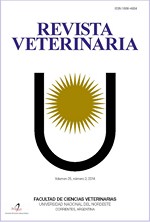Genotype x feeding regimen interactions in free-range chicken production
DOI:
https://doi.org/10.30972/vet.3013898Keywords:
Chicken, body weight, feed efficiency, slaughter traits, three-way crossAbstract
Poultry meat production in semi-intensive management systems is an ecological modality that takes into account aspects related to animal welfare. Campero chicken is a bird with a slower growth rate than commercial broilers destined to the production of meat in this type of systems. The traditional feeding scheme includes the use of three types of food specially formulated for this purpose (starter, grower and finisher) which introduces management complications, particularly in relation to the availability of grower food for small producers. An alternative that would facilitate feeding management is a scheme based on only two types of food: starter and finisher. The aim of this work was to evaluate the effect of changing the traditional feeding scheme by an alternative one, replacing grower food with a mix of starter and finisher, in two genotypes of chicken with a different growth rate: the experimental three-way cross Campero Casilda and the two-way cross Campero INTA. The evidence indicates that the proposed change in the traditional feeding management does not affect body growth, feed conversion ratio and productive traits at slaughter, and that both genetic groups behave similarly, when grower diet is replaced by a mix of starter and finisher.
Downloads
Downloads
Published
How to Cite
Issue
Section
License
Copyright (c) 2019 A M. Dottavio, B M. Romera, Z E. Canet, R J. Di Masso

This work is licensed under a Creative Commons Attribution-NonCommercial 4.0 International License.
Revista Veterinaria (Rev. Vet.) maintains a commitment to the policies of Open Access to scientific information, as it considers that both scientific publications as well as research investigations funded by public resources should circulate freely without restrictions. Revista Veterinaria (Rev. Vet.) ratifies the Open Access model in which scientific publications are made freely available at no cost online.











.jpg)
.jpg)



